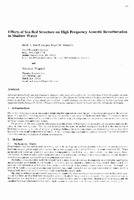| dc.contributor.author | Terril-Stolper, Heidi A. | |
| dc.contributor.author | Meredith, Roger W. | |
| dc.contributor.author | Wagstaff, M.D. | |
| dc.date.accessioned | 2018-10-11T14:08:24Z | |
| dc.date.available | 2018-10-11T14:08:24Z | |
| dc.date.issued | 1997 | |
| dc.identifier | 11511 | |
| dc.identifier.govdoc | CP-45 | |
| dc.identifier.uri | http://hdl.handle.net/20.500.12489/470 | |
| dc.description.abstract | Although undoubtedly sea bed structures, patterns, and composition affect the reverberation of high-frequency acoustic energy, the extent of their influence is not well known. The effects of varying selected bedform parameters for sandy sea floors in shallow water at two depths are modeled. Visible changes are observed for different bedform patterns and sandwuvelength changes of -0.5 m. Changes of 0.05 in the sand wave height-to-length ratio are statistically detectable. | |
| dc.format | 8 p. : ill. ; digital, PDF file | |
| dc.language | English | |
| dc.publisher | NATO. SACLANTCEN | |
| dc.source | In: High Frequency Seafloor Acoustics (SACLANTCEN Conference Proceedings CP-45), 1997, pp. 547-554 | |
| dc.subject | Seafloor | |
| dc.subject | Acoustic reverberation | |
| dc.subject | High Frequency Acoustics | |
| dc.subject | Shallow water | |
| dc.title | Effects of sea bed structure on high frequency acoustic reverberation in shallow water | |
| dc.type | Papers and Articles | |
| dc.type | Conference Proceedings (CP) | |
